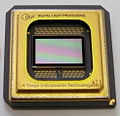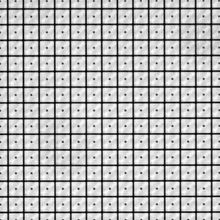Digital Light Processing
· 
Micro mirror array (DLP chip) from Texas Instruments in the housing
· 
Rear of the housing with connection contacts
Digital Light Processing (DLP) is a projection technology developed by the US company Texas Instruments (TI) and registered as a trademark, in which images are generated by modulating a digital image onto a light beam. The light beam is split into pixels by a rectangular array of movable micromirrors and then reflected pixel by pixel either into or out of the projection path.
The heart of this technology, the component that contains the rectangular array (matrix) of mirrors and their control technology, is called a DMD - Digital Micromirror Device.
In contrast to other methods, in which a real image or a real object is directly imaged optically, here - similar to laser projection - the image is only generated optically within the projection path. Therefore, strictly speaking, it is not a projection as defined in physical optics.
DLP is used, for example, for video projectors and rear projection screens in the home cinema and presentation sector; and under the name "DLP Cinema" in the digital cinema sector. The technology has been licensed to various projector manufacturers. DLP is also used in the industrial sector for additive manufacturing. Furthermore, the technology is used commercially in microscopes for neuroscientific research for the optogenetic control of the activity of nerve cells through photostimulation.

Enlarged section (approximately 0.2 mm by 0.2 mm) of a DLP chip with approximately 13 µm by 13 µm square micromirrors in fourteen rows and columns each
Digital micromirror device
The central component of DLP projectors is a microsystem called a Digital Micromirror Device (DMD). This is a spatial light modulator (SLM). It consists of micro mirror actuators arranged in a matrix, i.e. tilting mirror surfaces with an edge length of about 16 µm. In commercially available systems, the movement is caused by the force of electrostatic fields. Each micromirror can be individually adjusted in its angle and usually has two stable end states between which it can change up to 5000 times within one second. The number of mirrors corresponds to the resolution of the projected image, whereby one mirror can represent one or more pixels. DMD chips with resolutions up to 4096 × 2160 pixels (4K) have been available since 2010.
Since the introduction of DMD technology, an important aspect of the further development of the technology, in addition to an increase in resolution, has been an improvement in contrast. For this purpose, two improvements in particular were developed until about 2002, which are called "small rotated via" (SRV) and "small mirror gap" (SMG). The via is the tubular structure that connects the mirrors to the substructure. Here, a reduction in the size of this hollow component has resulted in fewer reflections/scattered light and thus a 50 percent improvement in contrast. The light falling between the mirrors and reflected from the substructure could be reduced by reducing the distances between the mirrors using SMG (30% contrast improvement), which also improved the fill ratio. Finally, a new inorganic coating of the metallic substructure called "Dark Metal 3" was introduced. Another change to improve contrast was to increase the tilt angle of the mirrors from 10° to 12°.
These improvements were apparently integrated into the "Darkchip 2" introduced in 2004. The subsequent "Darkchip 3", introduced in 2005, continued the above measures. Finally, the "Darkchip 4", introduced in late 2007, brought a further 30% increase in contrast due to advances in lithography and other process changes, according to Texas Instruments. In 2011, the majority of models on the market were equipped with the Darkchip 2 or the Darkchip 3; the Darkchip 4 was less widespread.
In the fall of 2015, Texas Instruments introduced a new DMD with a resolution of 4 million pixels at a diagonal of 0.7 inches for low-cost 4K projectors. The chip is moved back and forth between two positions by a mechanism in order to be able to display the 8 million pixels available in 4K in two offset partial images.
Factors that contribute to the contrast of a particular projector include, in addition to the actual DMD, the iris used, the light-generating and focusing section, the light trap (absorber) for the deflected light, and the coating and low-reflection properties of glass and other surfaces in the lens.

Principle operation of a single mirror in a DMD. The second arrow from the left shows the beam path of the dropout light in the mirror's rest position without voltage applied.
Image generation
Different brightness levels of the individual pixels are generated via a binary pulse-width modulated control of the mirrors. For example, 5 states are required to display 32 (= 25) brightness levels. These differ in how long the DMD is switched (see also binary code and dual system). In the first state (bit 0), the mirror is on or off (1 or 0) for the shortest possible time. At the next state (bit 1) the time doubles and so on. The total time for one cycle is thus 496 µs for 5 bits. The principle is illustrated in the adjacent drawing. In practice, a slightly modified control is used for a visually better representation. All bits except bit 0 and 1 are divided into individual sections, which are distributed over the entire cycle (so-called bit division). This corresponds approximately to pulse density modulation.

A cycle of a DMD with two exemplary brightnesses
Questions and Answers
Q: What is a DLP projector?
A: A DLP projector is a type of video projector that uses small mirrors to reflect light to create images.
Q: How do the mirrors in a DLP projector work?
A: The mirrors in a DLP projector can be moved to either reflect light or not reflect light. When the mirror reflects light more often, it makes a lighter color. When the mirror reflects light less often, it makes a darker color.
Q: What are some advantages of DLP projectors?
A: DLP projectors can be bright and have a high resolution, which can make the picture look better. They can also be small and lightweight, making them easy to move and transport.
Q: Can DLP projectors be used in smartphones?
A: Yes, some DLP projectors are small enough to fit in smartphones.
Q: Where are big DLP projectors often used?
A: Big DLP projectors are often used in movie theaters.
Q: What makes DLP projectors different from other types of projectors?
A: DLP projectors use small mirrors to reflect light, while other types of projectors may use different methods such as LCD panels or LCoS.
Q: Can DLP projectors be used for both home and professional purposes?
A: Yes, DLP projectors can be used for both home and professional purposes, as they come in a variety of sizes and resolutions to fit different needs.
Search within the encyclopedia